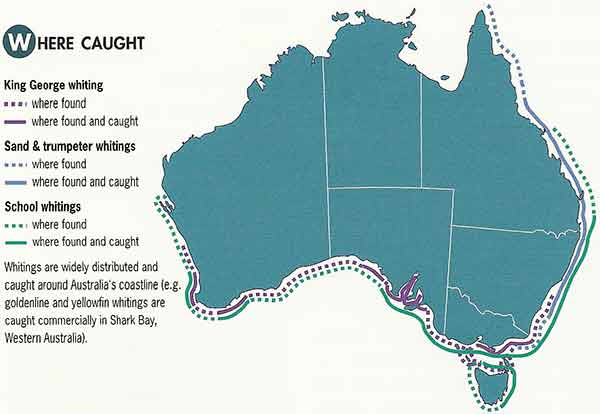Eastern school whiting is prized for its sweet, delicate flavour.
They are versatile fishes that can be prepared in a number of ways including steaming, baking, barbecuing and grilling, but the most common is frying.
Careful handling is required because of their soft and delicate texture.
Download our species guide on common species caught in AFMA managed fisheries.
Catch limits
| Catch limit | Fishing Mortality* | Biomass** |
|---|---|---|
Catch Limit 914 tonnes For the 2024–25 Season | G;Not subject to overfishing | G;Not overfished |
* Fishing mortality status relates to the level of fishing pressure on a stock – specifically, whether fishing mortality in the year being assessed is likely to result in the stock becoming overfished or prevent the stock from rebuilding from an overfished state. If fishing mortality exceeds either of these thresholds, a stock is considered to be subject to overfishing.
** Biomass status relates to how many fish there are – specifically, whether the biomass in the year being assessed is above the level at which the risk to the stock is considered to be unacceptable. The HSP defines this level as the limit reference point, below which the stock is considered to be overfished.
Scientific name: Sillago flindersi
Family: Sillaginidae
Other names: Bass Strait whiting, red spot whiting, school whiting, silver whiting, spotted whiting, transparent whiting
Description: Eastern school whiting have slightly compressed, elongated bodies, and two dorsal fins. The first dorsal fin has 11 spines and the second dorsal fin has one spine. The anal fin has two spines. The body is a pale sandy colour on top and silvery white below, with diagonal lines of red spots on the upper sides.
Size (length and weight): Up to 33 cm in length and 0.2 kg. Few are seen larger than 25 cm in length.
Life span: Up to 7 years.
Habitat: Eastern school whiting are a benthic species found from shallow tidal flats down to depths of 180 metres on the continental shelf. They are usually associated with sandy substrates. Juveniles tend to be found in shallower waters than adults.
Prey: Crustaceans, molluscs and polychaetes.
Predators: Birds, larger fish, sharks, rays and marine mammals such as dolphins.
Reproduction: Eastern school whiting reach reproductive maturity at about 2 years of age. Spawning is regionally variable, and occurs from October to March in the eastern Bass Strait, late summer in Tasmania, and during winter in northern New South Wales. Females spawn twice each year in deeper waters. Females produce 30 000‑110 000 eggs per spawning season depending on their body size.
| Fishery | Gear | Catch of this species is targeted or incidental |
|---|---|---|
| Southern and Eastern Scalefish and Shark Fishery – Commonwealth Trawl Sector | Danish seine | Targeted |
| Southern and Eastern Scalefish and Shark Fishery – Commonwealth Trawl Sector | Bottom trawl | Incidental |
| Southern and Eastern Scalefish and Shark Fishery – Gillnet Hook and Trap Sector | Scalefish hook | Incidental |
The Commonwealth catch of eastern school whiting is managed by quota. This means the catch of this fish by commercial fishers is restricted by weight.
Commercial fishermen are required to fill in records of their catches, during each fishing trip and when they land their catch in a port. This helps us keep records of how much is being caught.
AFMA decide on the amount that can be caught each year from expert advice and recommendations from fisheries managers, industry members, scientist and researchers.
Eastern school whiting live close to the sea bed over sandy substrates between the surface zone and 80 metres.
Eastern school whiting are found in Australian waters from southern Queensland to Anxious Bay, South Australia, and the east coast of Tasmania.
They are caught throughout the year, though larger catches are commonly seen between March and July.

The two main fishing methods used to catch eastern school whiting are Danish seine and bottom trawling.
Sometimes, bottom trawling can catch unwanted species of fish (not the type of fish the net was supposed to catch). This is known as bycatch and it is monitored by on-board fishery observers who assess the environmental impact of the trawling.
Although it is not physically possible to trawl on reef structures, significant long-term damage can occur if sensitive habitat areas like corals, sponges and seagrass beds are trawled. To ensure these sensitive habitat areas are protected from trawling, management arrangements such as area closures are extensively used.
AFMA carries out ecological risk assessments (ERA) for all of its major fisheries. The impact of demersal otter board trawl and Danish seine on bycatch species and habitats has been assessed as part of the ERA. AFMA mitigates, or reduces, that impact through its ecological risk management (ERM) strategy. The ERM details a number of management arrangements and strategies which aim to reduce the impact of fishing on the environment.In the Commonwealth Trawl Sector this includes:
- minimum mesh sizes for bottom trawls to reduce the catch of small and juvenile fish
- mitigation devices to reduce interactions with threatened, endangered and protected species
- and closing areas to fishing to protect vulnerable species and habitats.
Gear
Want to know more?
This is just an overview of eastern school whiting, if you want to know more see the links below.
This fish is managed under the Southern and Eastern Scalefish and Shark Fishery.